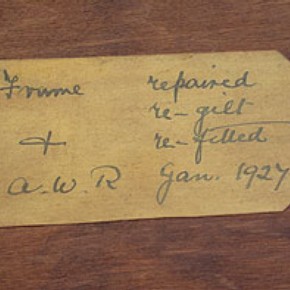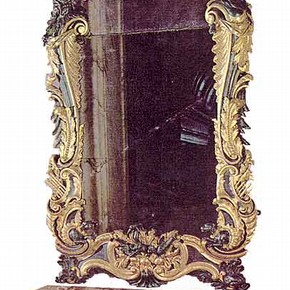Conservation Journal
Summer 2005 Issue 50
Picture and mirror frames: Reflections on treatment past, present and future
The V&A has a large collection of European gilded picture and mirror frames both on display and in storage. These date predominantly from the 18th and 19th centuries with a small number of earlier and later examples. The painting collection is mainly framed in 19th century British and some French composition frames, many of these can be seen on display in the new Paintings Galleries. Earlier elaborately carved and gilded 18th century British mirror and picture frames are on display in the British Galleries. During the 19th and 20th century the V&A also acquired a collection of Renaissance mirror and picture frames dating from the 15th century. Overall, the collection of mirror and picture frames are made from a variety of materials and techniques such as carved wood, papier-mâché, composition and leather. Decorative techniques include tooled and raised gesso work, sgraffito, oil and water gilding and japanning.
This article will give a brief overview of some of the current conservation treatments carried out on frames in the Conservation Department at the V&A. We will also consider past treatments and attitudes and look forward to their future care. As the ethics, materials and processes in the conservation of mirror and picture frames are many and often complex they cannot be considered in great detail here. However our current approach to treatments is summarised below, illustrated with examples from past and present exhibitions.

Figure 1: Hand-written label recording treatment found on the back of a 19th century frame. Photography by Zoë Allen (click image for larger version)
Existing documentation is examined prior to deciding treatment, consulting both collections and conservation files. There are few written conservation records regarding the treatment of mirror and picture frames prior to 1980. However occasionally V&A treatment of frames was briefly recorded on hand written labels attached to the backs of picture frames, on backboards or on the back of the paintings stretcher (Figure 1). The object is examined closely to assess its condition and identify the presence of any earlier schemes as the appearance of gilded objects is often changed over time due to repair or change in tastes or fashions.
After examination different levels of treatment are proposed and discussed with curators. Minimal treatments usually include stabilising the structure and surface decoration through consolidation, light cleaning, such as removal of dust, and toning out any distracting losses. More complex treatments include compensation of losses, further cleaning, removing or improving past treatments and revealing or re-creating earlier schemes.
A good example to illustrate how an object's appearance can change is the Lock Table and Mirror, circa 1745 (W8-1960), on display in the British Galleries. The first scheme, probably the original, was water gilding applied all over. Later a second decorative scheme of gold and dark green was applied (Figure 2), probably in the early 19th century to update the appearance according to fashionable trends of the time, with the green imitating bronze. Then in 1984, for the V&A 'Rococo' exhibition, gilding conservator Malcom Green was asked to recreate the original fully gilded appearance of the first finish. This was achieved by gilding over the green elements.

Figure 2: Second decorative scheme of gold and dark green. 'Casa D'oro' Issue 52, November 1967 (click image for larger version)
Once it is decided how the object should finally appear and treatment has been agreed with curators and signed off, the object is photographed. Risk assessments are carried out prior to treatment commencing to cover all processes such as manual handling, materials and equipment. Treatment is then carried out with every attempt to facilitate concerns of reversibility and detectability. All treatment and findings, such as previous schemes, are documented using text and image. Materials and techniques used for the conservation of gilding and other decorative finishes on frames are discussed in further detail in previous articles.1
In addition to treating the decorative surfaces preventive conservation treatments are also carried out. A main function of picture frames is to protect the paintings they surround. The addition of glazing and backboards acts as a buffer from pollution, dust and fluctuations in RH. UV inhibiting low reflective glass also provides protection from light damage. More vulnerable panel paintings are occasionally fitted in a microclimate box, which is accommodated into the frame. These alterations and additions to the frame often result in the painting standing proud at the back of the frame and the sides of the paintings are exposed. In these cases the frame is built up behind to accommodate the extra depth. All paintings in the recently opened Paintings Galleries were re-glazed and build ups and back boards attached where required.
Paintings on display and going on loan from the V&A that are larger than one meter are generally glazed with UV inhibiting low reflective laminated glass.2 This protects both the painting during transportation, object handlers and those coming into close contact from risk, as it does not shatter if broken. Laminated glass has the disadvantage of being heavy and for large frames, such as 'The Tree of Life' by Burne-Jones (Circ. 525-1953) on display in the 'International Arts and Crafts' Exhibition, the main joints of the frame often have to be reinforced.
Where glazing has been added spacing strips are fitted to stop the painting coming in contact with glass. Black velvet ribbon is placed on these to protect the front of the painting and any gaps at the back are taped to prevent the ingress of dust. Old fittings such as rusting nails, which originally held the paintings in place, are replaced with brass mirror plates cushioned with plastazote‚ which is also used to fill any gaps between the painting and the rebate.
The main preventive conservation measure for mirror frames is the protection of the original mercury-tin amalgam mirror finish applied to the back of the glass from dust ingress and handling. The backs may have original protection in the form of paper sheets or wooden boards, however the paper may have become torn and the boards split. Gaps in boards are covered with gummed linen tape or for larger areas Tyvek®‚ sheet is used held with the tape, avoiding any contact being made with the mirror back. These methods slow dust ingress but allow air movement.3 Labels and where possible original backing paper on both mirror and picture frames are protected with melonex or removed and stored on file.
Over the years frames have been increasingly valued as objects in there own right. We look forward to spending more time analysing and treating the frames within the collection for future projects. When planning for future display, objects are surveyed to assess condition, treatment needs and the best examples of type, before the final selection is made. At present we are surveying renaissance picture and mirror frames for possible display in the Mediaeval & Renaissance Galleries. The collaboration of curatorial art historical research together with technical analysis from conservation and science helps us to better understand and authenticate our collections.
The future of the mirror and picture frame depends on preventive conservation on a wider level. Current and continuing improvements to storage and display, environmental control, housekeeping and maintenance and care of our core collection will ensure the longevity of the mirror and frame collection.
References
1. Mallinson, F., Allen. Z., & Powell, C., Gilded Objects Treated for the British Galleries. 'V&A Conservation Journal' 39, Autumn issue (2001), pp.10, 11
Powell, C., Working with Gilded Furniture for the British Galleries Project at the V&A. 'Gilding: approaches to treatment'. James and James (Science Publisher) Ltd, (2001), pp. 67-74
2. There is no law requiring this, however it is standard practice as carried out by other conservation departments such as the Tate. What does appear to be a legal requirement however is that if any glass (larger than 250mm) is on display below 1500mm then it is a requirement by Buildings Regulations 1991 to have laminated glass.
3. Powell, C., Preventative Conservation of eighteenth century tin-amalgam mirrors in the V&A British Galleries. Gilding and Decorative Surfaces Section, 'UKIC Conservation News' Issue 85 (July 2003), pp. 29-31
Suppliers
Plastazote®, Polyformes Ltd, Cherry Court Way, Stanbridge Road, Leighton Buzzard, Bedfordshire, LU7 8UH
Tyvek®, Preservation Equipment Ltd, Vinces Road, Diss, Norfolk, IP22 4HQ
Summer 2005 Issue 50
- Editorial
- Rising damp - a history of the Conservation Department
- V&A Conservation on the world wide web: a secondment to the V&A web team
- The ethics checklist - ten years on
- Plastics preservation at the V&A
- Working for Diaghilev
- Pugin's wallpapers from The Grange
- Prevention is better than the cure
- Research
- The Castellani diadem
- In pursuit of a clear answer: An Exhibition Road partnership
- Investigation of the room temperature corrosion of replica museum glass
- Professional collaboration - the Prince of Wales Museum of Western India
- V&A/RIBA partnership
- Picture and mirror frames: Reflections on treatment past, present and future
- A simple solution?
- Appendix 1: Victoria & Albert Museum Conservation Department Ethics Checklist
- Conservation of a tortoiseshell book cover
- The hand that rocks the cradle: Conservation administration, present and future
- Printer friendly version